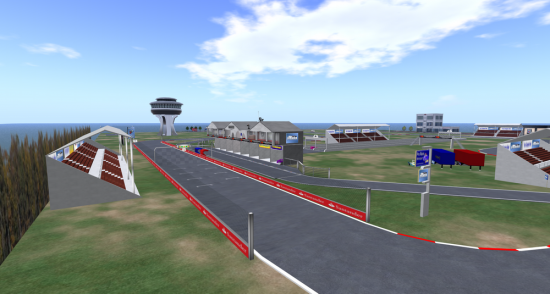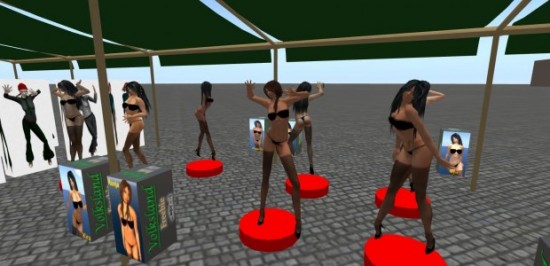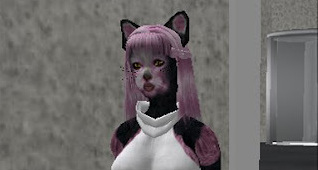With the recent explosion in new OpenSim grids, it will get harder and harder to get noticed. I’ve been talking about this to new gridmasters, and thought I’d share the advice a bit more widely.
While I’m specifically writing for hypergrid-enabled grids, some of the same advice will apply to closed grids, as well.
It is much more difficult to apply these principles to a sub-continent on an existing grid, since the parent grid might have a different marketing plan and brand identity which can conflict with yours.
Pick a theme
Whenever you start marketing a new product, you have to figure out its Unique Selling Proposition.
What makes your grid different from other grids?
The ideal is to find a community that isn’t currently served, or served well, by existing grids, a community that you have strong ties with and easy access to.
For example, Cyber Wrld grid’s founder and CEO Timothy Rogers identified a lack of a hypergrid community for furries and created a grid where folks interested in the furry community can find furry avatars and other furry-related freebies, and also find other like-minded people.
Another grid with a strong and unique community identity is Littlefield, which serves the BDSM population.
Other communities that are currently under served includes any language communities other than English, German, French, Dutch, or Italian. In addition, while there’s a grid serving gay men — S-Grid — and a closed grid called Gay Nations, which serves the entire GLBT community — there is no grid on the hypergrid serving lesbians. And we all know how popular lesbians are in the virtual world. Other groups which could benefit from a supportive community are people with Asberger’s or Autism, people looking to lose weight, or people who belong to particular political parties.

Other potential themes are popular hobbies such as model railroading or virtual farming. For example, TG Grid focuses on car racing. Proprietary role playing games can also serve as the basis for unique grids. A theme can also be a popular book — or an out-of-copyright classics like fairy tales, myths, or books like The Wizard of Oz.
Unique Selling Propositions could also be unique features — lowest prices, biggest community, unique physics engine or scripting commands. For example, Kitely‘s Unique Selling Proposition is its on-demand pricing model. It also has the easiest interface of any grid. OSGrid‘s Unique Selling Proposition is its position as the main testing ground for new releases of OpenSim. It is also the largest of all the grids.
Memorable name
For some reason, a very large number of grids have the words “virtual,” “cyber,” “life,” “sim,” “world,” “realm,” “avatar,” “metaverse,” “open,” “universe,” and, of course, “grid.” For example, we have twenty grids with the word “virtual” in their names in our database.
Don’t make your potential customers wonder if it was “Virtual Life Grid” or “Living Virtual Grid” or “Virtual Grid Living Sims” that they wanted to find out more about.
A good name is memorable, evocative and creates an emotional association for the customer. It can be very difficult to create a strong emotional association with a generic name, or a name that sounds a lot like that of another grid. Not impossible, but difficult. InWorldz, for example, has strong brand name recognition.

I personally love the names of the Littlefield and Speculoos grids — very unique, evocative, and easy to brand.
It also helps if your grid is easy to Google. A grid named “Hot Chicks,” for example, will have a hard time making it to the first page of Google search results. Make sure that the name is easy to spell and the URL is available, ideally with a dot-com extension.
Get the name out
Get the grid added to the Hyperica and Hypergrid Business hosting directories and our Active Grids List by emailing us at editor@hypergridbusiness.com. To get listed in our monthly grid stats review, put up a page where we can get your statistics — total regions, total registered users, and active 30-day users. You should also add your grid to the OpenSim grid list at opensimulator.org and to the HG Directory.
To get listed at The Hypergates, you should get a copy of their gate and install it anywhere on your grid.
We’re also — for now — giving away free ads both on our Hyperica website and on in-world bulletin boards. Get your free Hyperica ad here.
You can also purchase ads on this and other blogs, and send out announcements to members of relevant social networks.
And, of course, you need a website, a Twitter account and a Facebook page. You can see the Twitter feeds of other grids by following my OpenSim Grids Twitter list.
Six points of contact
A sales and marketing rule-of-thumb is that it takes six points of contact before someone makes buying decisions.
So, for example, if you want people to buy land on your grid, you need to figure out six ways to connect with your potential customers.
Potential customers might see a write-up of your grid on a blog, see your grid in The Hypergates, see an ad for your grid at a Hyperica terminal, read a comment you posted on a popular discussion threat — where your grid’s name is in your signature, visit a freebie store on your grid, and attend an event on your grid.
You want to make the points of contact memorable, as well, and memorable in a good way. For example, if you’re attracting visitors to your grid with a freebie store, put the name of your grid in the item names or descriptions, and include a hypergrid landmark that takes them back to your grid. It also helps if the freebies are unique or extremely useful — each time the customer pulls them out, they’ll be reminded of your grid.
And freebies aren’t limited to just in-world items. You can give away starter regions — terrains, OARs — on your website. Each time someone visits for a download, it’s another opportunity to convince them to check out your grid. And if the freebies are good, they’ll pass around the link to your website.
You never know which point of contact will be the one where your visitor finally says, “I love this place. I have got to get some land here.” So make sure that it’s easy to make a purchase — a link to your land sales page should be prominent on the front page of your website and all internal pages, and teleport links to your land rental office should be prominently located at key grid locations. Â It doesn’t have to be an in-your-face screaming billboard, but if the customer looks for it, it should be easy to find.
Help out word of mouth
Word of mouth is the best sales technique — people trust their friends more than they trust advertisements or random bloggers.
Make it easy for your satisfied customers to spread the word by encouraging them to post photos of their builds on your Facebook page.
You can also provide venues and support where your customers can hold public events, to which they can invite their friends from other grids. Events that might draw outside visitors include art shows and fashion shows, book clubs, support groups, contests and games, open mike nights, building and scripting lessons, poetry slams, and movie premieres.
A good event venue should have high avatar capacity. It should be easily configurable for different types of events, and be clearly branded with the grid’s colors and logos. Grid landmarks should be easily available for those who might want to come back later.
Shopping destinations also work well to help spread word-of-mouth since people will readily tell their friends where to find stuff.
I’m seeing many grids get started with Linda Kellie OARs and freebie stores, which is nice — her work is Creative Commons-licensed for any use on any grid. Some visitors will show up simply because they’re looking for her stuff.
But if you want people to come back — and to tell their friends about your grid — there should also be something special. This could be as simple as clothing branded with the grid’s logo, for folks who are collecting T-shirts or caps from every grid. Or items spotlighting the grid’s theme — a furry grid could give away or sell furry avatars, a racing grid could give away or sell sample race cars. You can also give away T-shirts promoting on-grid venues or events — your popular nude lesbian beach, your live music venue, your art galleries.
Lure in celebrities
Clubs and bars and fashion designers have long known the marketing appeal of a famous face — or a famous butt.
Celebrities not only attract people who want to hob nob with the celebrity, but also make the grid feel popular and in-demand.

For example, Linda Kellie recently moved her home to the Cyber Wrld grid and got a furry avatar. Not only does she have a few hundred followers on her Twitter account but she also has a legion of grateful fans using her  content and actively promoting her in their blogs, Facebook posts, and Twitter streams.
I’m not up on virtual gossip, so the only other celebrity I know of is Ener Hax — who has strongly endorsed the SimHost OpenSim hosting company.
You can’t buy that kind of publicity.
But you can buy other celebrity attention.
Track your results
You’ve seen other companies ask, “How did you hear about us?” They do it because they want to know which of their marketing strategies work best.
Take the opportunity to ask this question whenever you can. But you also automate this process a little bit.
For example, you can create landing pages for particular advertising campaigns, for your email signature, for your Twitter links, and other Web mentions.
You can also create in-world landing areas for people coming from The Hypergates, or from the landmarks you include with your freebies, or from in-world ad networks, or from partner grids, and set up visitor counters at those areas.
Some methods are going to work better, while others will just waste your time or money.
Keep in mind that your marketing channel choice could also become part of your marketing — for example, fifteen years ago, if someone was dropping a disk into your shopping bag, you would think of AOL. In some towns, a real estate agency dominate the buses. In my area, there’s a particularly loud furniture store that rules the radio waves.
On the hypergrid, any marketing strategy you come up with is likely to be unique — after all, there isn’t much marketing happening on the hypergrid just yet — which makes it easy to dominate.
- Kitely Mega Worlds on sale for $90 per month - July 19, 2024
- OpenSim regions up, actives down with summer heat - July 15, 2024
- People think AIs are conscious. What could this mean for bots in OpenSim? - July 12, 2024
